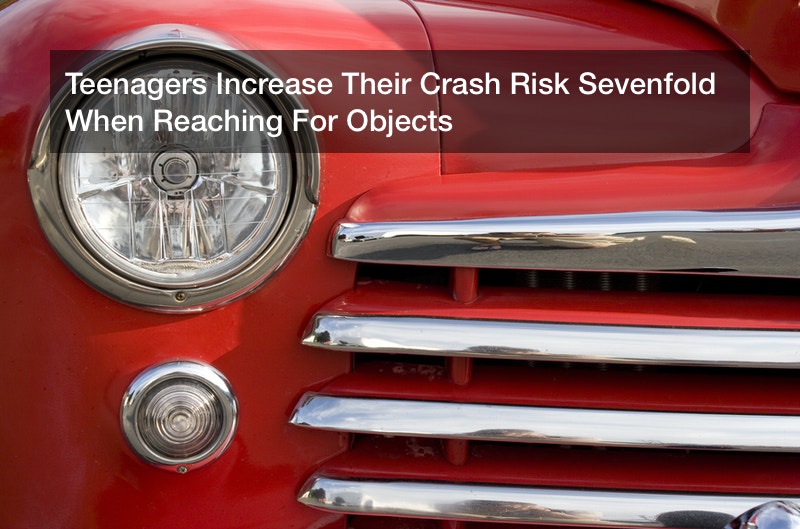Teenagers Increase Their Crash Risk Sevenfold When Reaching For Objects


Teenagers are seven times more likely to get into a car accident when reaching for objects while driving, a new study shows. According to a recent study by the National Institutes of Health, teenagers increase their crash risk sevenfold when they reach for items in their car such as food or makeup and double their risk when they use their phone.
Researchers at NIH followed 82 study participants in Virginia for one year. The participants were each newly licensed, so they likely had a clean driving record, and they were the average age of 16.48 years.
Participants’ vehicles were equipped with computers that tracked kinematics and assessed speed. A GPS, which was first introduced to automobiles in 1996, was also installed in the car to determine mileage. Video cameras were installed to watch the driver’s face, hands, and body positioning.
At the end of the study, researchers identified 71 crashes among the 82 participating drivers. There were 43 drivers who weren’t involved in a car accident, 25 that were involved in one accident, and 14 who were involved in two or more. Consider states like South Carolina where there are 62% more fatal car accidents than the national average — we may now have some insight into why.
Researchers evaluated the video footage in six-second segments before each accident to evaluate the severity, type of crash, and the contributing factors in the accident. Researchers also compared video segments randomly with footage where no crash occurred to establish a baseline of normal driving behavior.
In 56% of video segments where no crash occurred and 51% of segments where a crash did occur, drivers were performing secondary tasks. These tasks in both scenarios included interacting with passengers (21%), talking without a passenger present (17%), and attending to stimuli outside the vehicle (10%).
Manual cellphone use and reaching for objects weren’t the most common secondary tasks but were associated with increased crash risk compared to the baseline. Researchers found that, regardless of the type of distraction, the risk of crashing the vehicle increased by 28% for every second the driver’s eyes were off the road.
Despite this increased risk and the fact that 500,000 reefer trailers are currently operating on U.S. roads, another recent study found that 40% of teenage drivers text while driving.
The automotive industry uses 13% of the world’s steel to build vehicles and although they’re built with the driver’s safety in mind, up to 3 million people are injured in car accidents every year. Car accidents, according to the CDC, are the leading cause of death for Americans under the age of 18.
“During their first year of independent driving, teens often engage in many different activities behind the wheel that could lead to a crash,” said Dr. Pnina Gershon, the lead author of the NIH study. “Teenage drivers may benefit from interventions that monitor and alert them during frequent or prolonged inattention on the road.”
In 2016 alone, up to 2,433 teenagers in the U.S. between the ages of 16 and 19 were killed in a motor vehicle accident. Another 292,742 were treated in emergency departments for injuries related to a motor vehicle accident. Approximately six teenagers die in a car accident every day.
“The fact that new, young drivers get into so many car crashes is sad but also preventable,” says personal injury lawyer Kurt Zaner of Zaner Harden Law . “Distracted driving hits young and inexperienced drivers in a more amplified way, given how new they are to the road.”
It’s also worth mentioning that distracted driving is still one of the top causes of motor vehicle accidents regardless of the driver’s age.
“Nearly everyone, down to new drivers, has a smartphone with access to texting, calling, Internet, camera, GPS, etc,” said Lisa Hollister, the director of Don’t Text and Drive! for Trauma and Acute Surgery. “This is vastly different than when only a portion of society has flip-phones.”
Tina Willis of Tina Willis Law says:
“As an Orlando car accident lawyer, I receive calls on a regular basis from parents of young adults who have been seriously injured in car accidents. Just this week, I spoke with the mother of a young woman who was injured while traveling to one of her final exams during college. Young adults are often busy juggling work, school, hobbies, and many other responsibilities. At the same time, many haven’t experienced enough loss in life to be aware of the significant risks of driving on our roads. So parents can’t be vigilant enough when trying to educate their children about the many dangers of driving on the roads.
“We all need to be extra vigilant behind the wheel and constantly practice defensive driving. (I often tell my husband that he needs to always assume that another car could be coming in his lane at any time — thinking back to the many head-on collisions I’ve handled.) All drivers need to be much more cautious on the roadways to respect the extreme danger that tons of steel driving down the road at fast speeds creates. This is especially true when driving in bad weather, on crowded roads, or near much larger vehicles, like semi-trucks. We should also completely ignore our phones while driving, even if using bluetooth, and minimize all other distractions as much as possible. There is a lot of evidence that distracted driving increases the risk of serious accidents, which regularly lead to serious injuries and death on the roadways, often with the victims having no blame in causing the accident.”






